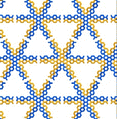 Open Access Article
Open Access ArticleCreative Commons Attribution 3.0 Unported Licence
Correction: Construction of isostructural hydrogen-bonded organic frameworks: limitations and possibilities of pore expansion
Yuto
Suzuki
a,
Mario
Gutiérrez
b,
Senri
Tanaka
c,
Eduardo
Gomez
b,
Norimitsu
Tohnai
d,
Nobuhiro
Yasuda
e,
Nobuyuki
Matubayasi
*c,
Abderrazzak
Douhal
*b and
Ichiro
Hisaki
*a
aDivision of Chemistry, Graduate School of Engineering Science, Osaka University, 1-3 Machikaneyama, Toyonaka, Osaka 560-8531, Japan. E-mail: hisaki@chem.es.osaka-u.ac.jp
bDepartamento de Química Física, Facultad de Ciencias Ambientales y Bioquímica, INAMOL, Universidad de Castilla-La Mancha, Avenida Carlos III, S/N, 45071 Toledo, Spain. E-mail: Abderrazzak.Douhal@uclm.es
cDivision of Chemical Engineering, Graduate School of Engineering Science, Osaka University, 1-3 Machikaneyama, Toyonaka, Osaka 560-8531, Japan. E-mail: nobuyuki@cheng.es.osaka-u.ac.jp
dDivision of Applied Chemistry, Graduate School of Engineering, Osaka University, 2-1 Yamadaoka, Suita, Osaka 565-7891, Japan
eJASRI, 1-1-1 Kouto, Sayo-cho, Sayo-gun, Hyogo 679-5198, Japan
First published on 29th November 2022
Abstract
Correction for ‘Construction of isostructural hydrogen-bonded organic frameworks: limitations and possibilities of pore expansion’ by Yuto Suzuki et al., Chem. Sci., 2021, 12, 9607–9618, https://doi.org/10.1039/D1SC02690A.
The authors regret that Table 2 of the original article requires correction. On page 9616 of the original article, the first line of Table 2 ‘periodicity of the framework’ is incorrect. The amended version of Table 2 is shown below:
| CPHAT-1 | CBPHAT-1 | TolHAT-1 | ThiaHAT-1 | |
|---|---|---|---|---|
| a Not determined. | ||||
| Periodicity of the framework/Å | 21.48 | 29.75 | 34.40 | 38.01 |
| RMSD of the HAT core plane/Å | 0.267 | 0.205 | 0.215 | 0.229 |
| Stacking distance/Å | 3.59 | 3.57 | 3.49 | 3.49 |
| Torsion angle of arms/° | 22.5 | 22.1 | 23.5 | 24.5 |
| Number of interpenetrations | 4 | 6 | 8 | 8 |
| Height of the channel aperture/Å | 6.4 | 14.5 | 19.2 | 18.0 |
| Void ratio | 0.31 | 0.45 | 0.55 | 0.48 |
| Pore width based on NLDFT/Å | —a | 12.4 | 16.6 | 15.5 |
| BET surface area/m2 g−1 | 649 | 1288 | 440 | 1394 |
| N2 uptake/mL (STP) g−1 | 21.39 | 361.7 | 155.2 | 415.7 |
| CO2 uptake/mL (STP) g−1 | 137.4 | 304.5 | 168.6 | 313.9 |
| Decomposition temp./°C | 339 | 307 | 190 | 305 |
| Ref. | Ref. 36 | Ref. 37 | This work | This work |
The Royal Society of Chemistry apologises for these errors and any consequent inconvenience to authors and readers.
| This journal is © The Royal Society of Chemistry 2022 |




